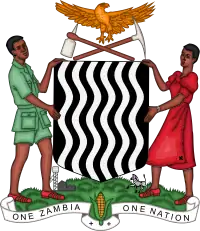National Assembly of Zambia
The National Assembly is Zambia's unicameral legislative body. Between 1972 and 1990, Zambia was a one-party state with the United National Independence Party (UNIP) as the sole legal party.[1]
National Assembly | |
|---|---|
 | |
| Type | |
| Type | |
| Leadership | |
Patrick Matibini since 6 October 2011 | |
| Structure | |
| Seats | 156 (+ Vice President and 9 appointees) |
 | |
Political groups | Government (89)
Opposition (63) Non-partisan
|
| Elections | |
| First-past-the-post | |
Last election | 11 August 2016 |
| Meeting place | |
| Lusaka | |
| Website | |
| National Assembly of Zambia | |
 |
|---|
| This article is part of a series on the politics and government of Zambia |
|
|
The current National Assembly, formed following elections held on 11 August 2016, has a total of 166 members. 156 members are directly elected in single-member constituencies using the simple plurality (or first-past-the-post) system. Nine additional seats are filled through presidential appointment. The Vice President is also granted a seat in the assembly.
Location
At the time of Zambia’s Independence in 1964, Parliament was housed in inadequate and unsuitable premises behind the Government’s Central Offices in Lusaka, commonly known as the Secretariat Area. It was, therefore, apparent at the time of independence that a more fitting Parliament building should be constructed to meet future expansion and also to provide adequate Members’ sitting and office accommodation.[2]
A site was chosen on the crown of a low hill in Lusaka which dominate the surrounding landscape and which was at one time site of the dwelling place of village Headman Lusaka, after whom the City of Lusaka is now named.[3]
The new National Assembly building was planned so that its external appearance expresses the dignity and power of Government, while internally, it is planned to function as a centre of administration. The focal point of the building is the Chamber, which is rich in decoration and colour in contrast to the rest of the building.[4]
2016 election results
| Party | Votes | % | Seats | +/– |
|---|---|---|---|---|
| Patriotic Front | 1,537,946 | 42.01 | 80 | +20 |
| United Party for National Development | 1,525,049 | 41.66 | 58 | +30 |
| Movement for Multi-Party Democracy | 99,356 | 2.71 | 3 | –52 |
| Forum for Democracy and Development | 79,489 | 2.17 | 1 | 0 |
| Rainbow Party | 34,906 | 0.95 | 0 | New |
| National Restoration Party | 10,887 | 0.30 | 0 | 0 |
| Alliance for Democracy and Development | 8,269 | 0.23 | 0 | –1 |
| United Democratic Front | 7,643 | 0.21 | 0 | New |
| United National Independence Party | 7,253 | 0.20 | 0 | 0 |
| Golden Progressive Party | 1,461 | 0.04 | 0 | New |
| Radical Revolutionary Party | 831 | 0.02 | 0 | New |
| Green Party of Zambia | 407 | 0.01 | 0 | New |
| United Progressive People | 333 | 0.01 | 0 | New |
| Independents | 347,005 | 9.48 | 14 | +11 |
| Invalid/blank votes | 92,044 | – | – | – |
| Total | 3,752,879 | 100 | 156 | +6 |
| Registered voters/turnout | 6,698,372 | 56.03 | – | – |
| Source: Electoral Commission of Zambia, Daily Mail | ||||
Previous National Assembly election results
| Political Party | Election Year | ||||||||||
|---|---|---|---|---|---|---|---|---|---|---|---|
| 1964 | 1968 | 1973 | 1978 | 1983 | 1991 | 1996 | 2001 | 2006 | 2011 | ||
| United National Independence Party (UNIP) | 55 | 81 | 125 | 125 | 125 | 25 | - | 13 | -* | - | |
| Movement for Multi-Party Democracy (MMD) | - | - | - | - | - | 125 | 131 | 69 | 74 | 55 | |
| Patriotic Front (PF) | - | - | - | - | - | - | - | 1 | 44 | 60 | |
| United Party for National Development (UPND) | - | - | - | - | - | - | - | 49 | -* | 28 | |
| Alliance for Democracy and Development | - | - | - | - | - | - | - | - | - | 1 | |
| Forum for Democracy and Development (FDD) | - | - | - | - | - | - | - | 12 | -* | 1 | |
| United Democratic Alliance (UDA) | - | - | - | - | - | - | - | - | 27* | - | |
| United Liberal Party (ULP) | - | - | - | - | - | - | - | - | 2 | - | |
| Heritage Party (HP) | - | - | - | - | - | - | - | 4 | - | - | |
| National Democratic Focus (NDF) | - | - | - | - | - | - | - | - | 1 | - | |
| Zambia Republican Party (ZRP) | - | - | - | - | - | - | - | 1 | - | - | |
| African National Congress (ANC) | 10 | 23 | - | - | - | - | - | - | - | - | |
| National Progressive Party (NPP) | 10 | - | - | - | - | - | - | - | - | - | |
| National Party (NP) | - | - | - | - | - | - | 5 | - | - | - | |
| Agenda for Zambia (AZ) | - | - | - | - | - | - | 2 | - | - | - | |
| Zambia Democratic Congress (ZDC) | - | - | - | - | - | - | 2 | - | - | - | |
| Independents | - | - | - | - | - | - | 10 | 1 | 2 | 3 | |
| Others | - | 1 | 11 | 11 | 11 | - | - | - | - | 11 | |
| Total | 75 | 105 | 136 | 136 | 136 | 150 | 150 | 150 | 150 | 159 | |
| *UPND, FDD, and UNIP contested the 2006 election under the UDA alliance[5] | |||||||||||
See also
References
- Mushingeh, Chiponde (1994). "Unrepresentative 'democracy': One-Party Rule in Zambia, 1973-1990". Transafrican Journal of History. 23: 117–141. ISSN 0251-0391. JSTOR 24520273.
- "National Assembly". National Assembly. 2020-05-27. Retrieved 2020-05-27.
- "National Assembly". National Assembly. 2020-05-27. Retrieved 2020-05-27.
- "National Assembly of Zambia". National Assembly of Zambia. 2020-05-27. Retrieved 2020-05-27.
- "Inter-Parliamentary Union". Inter-Parliamentary Union. Retrieved May 24, 2020.